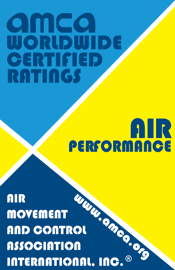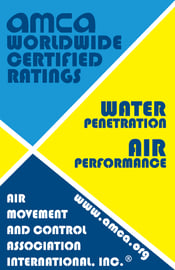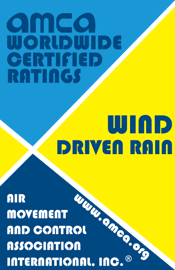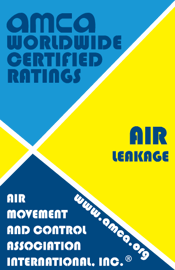AMCA Ratings can help you determine which louvers are best at a given task. What do they mean?
AMCA - A Quick Review![]()
Let's start with a quick review.
AMCA is the Air Movement and Control Association: an international, not-for-profit association of manufacturers who build air-system components, including fans, louvers, dampers, air-flow measurement devices, and other HVAC components.
AMCA establishes reliable standards and test protocols for HVAC equipment. AMCA applies an AMCA Rating Seal to any air-flow product that passes testing under its protocols. Industry professionals seek AMCA seals when selecting air-control products, because they know the manufacturer's data is reliable.
Ready to start a new project that requires weather protection? Contact Arrow United Industries about our line of severe weather louvers.
Air Performance
The AMCA seal for Air Performance refers to a louver's ability to allow air to pass through its free area with minimal resistance.
Tests measure the louver's pressure drop - the change in air pressure as ventilation passes through the louver - at various air velocities. Testers record these data points on a graph. Follow this graph to determine the amount of pressure drop for the louver at a given air velocity.
An AMCA seal of air performance means that an approved facility performed an approved test to collect this data, using standardized AMCA methods. Review the pressure drop data provided on the louver's submittal.
Water Penetration
The AMCA seal for Water Penetration refers to a louver's ability to block light rainfall. The primary data point for this seal is the beginning point of water penetration. Testers install a louver into simulated ductwork and subject it to rainfall. Intake air passes through the rain and through the louver, increasing in velocity as the test progresses.
The test is complete when 0.01 ounces of water pass into the ductwork, or if the air velocity has reached a maximum velocity threshold of 1250 feet per minute (FPM) without accumulating the maximum amount of water allowed. The beginning point of water penetration is the moment in air velocity that rain passes through the louver. Testers record the beginning point as "greater than 1250 FPM" if the air velocity reaches 1250 FPM before 0.01 ounces of water infiltrates the louver.
Like air performance, the seal for water penetration shows the accuracy of test data. Each seal confirms the data presented comes from a standardized test developed by AMCA and approved by ANSI. When you see the seal, check the louver's water penetration data to determine its capabilities.
Learn more about water penetration testing with the Newsstand: AMCA Testing - Water Penetration.
Wind Driven Rain
The AMCA seal for Wind Driven Rain refers to a louver's ability to block rainfall carried by high winds. Unlike the Water Penetration test, the Wind Driven Rain test involves several data points: air velocity and air ventilation through the louver's free area, an effectiveness ratio and an effectiveness rating class. Like the water penetration test, technicians install the louver into simulated ductwork and subject it to rainfall. For the wind driven rain test, fans will push rain into the louver’s face, simulating gusts of wind pushing air through the louver.
The test comprises two stages. Stage one subjects the louver to heavy rain conditions: 3 inches of rainfall per hour at wind velocities of 29 miles per hour. Stage two simulates a severe storm: 8 inches of rainfall per hour at a wind velocity of 50 MPH. Technicians collect and record data at several moments throughout each stage as the air velocity increases. At each recorded data point, the louver receives an “effectiveness rating” that dictates how well the louver blocks the rainfall. The effectiveness rating is a percentage and a letter grade from A to D, which is the effectiveness rating class.
When you see the wind driven rain seal on a louver's submittal, look to the louver's effectiveness rating class. This will help you determine how the louver performs in severe weather.
Learn about the wind driven rain test with this Newsstand article.
Air Leakage
For adjustable-blade louvers, an air leakage seal refers to the louver's ability to keep air from passing through blades in the closed position. The test for air leakage measures that amount of air volume that passes through closed louver blades at various static pressures. Technicians record the results on a curving line graph.
This leakage can drag your system down. Learn how in "Air Leakage".
Like all AMCA seals, the Air Leakage seal only shows that AMCA-approved test standards and methods produced the results. Be sure to check the air leakage graph on the louver's submittal to determine its effectiveness.
The AMCA Statement
An AMCA statement follows every AMCA seal displayed on a submittal. The statement is a required part of the seal in submittal documents. Submittal documents must display the statement beside the AMCA seal to clarify its purpose.
The AMCA statement for each seal clarifies the seal's purpose. The seal pertains only to the product displayed, for the performance seal shown, by the manufacturer of that product. This is the statement:
[Licensee’s name] certifies that the [product designation] shown hereon [or herein] is licensed to bear the AMCA seal. The ratings shown are based on tests and procedures performed in accordance with AMCA Publication 511 and comply with the requirements of the AMCA Certified Ratings Program. The AMCA Certified Ratings Seal applies to [AMCA Ratings] only.
Licensee = The manufacturer
Product Designation = The model number of the product
AMCA Ratings = The AMCA ratings applied to the product
The AMCA statement beside each seal eases any confusion about what the seal means and what it pertains to. This way, everyone knows that an air performance seal for a manufacturer's louver is only for air performance and does not pertain to other louvers, no matter how similar they are in design.
%20copy.webp?width=600&height=310&name=Hubspot%20Blogs%20-%20AMCA%20540%20-%20hurricane%20lineup%20(Resize)%20copy.webp)
AMCA seals are there to provide peace of mind. You can trust a product's performance when it bears an AMCA seal. The data for that louver comes from a trusted source adhering to reliable standards.
Would you like to know more? Learn about louvers with these Newsstand articles:
Which AMCA seals do you look for on your HVAC products? Do you find certain seals more common than others? Share your thoughts in the Comments section. We want to hear from you!
Do you have a question on something we haven't covered here? Contact MCDLG by clicking on the button below.
.webp?width=91&height=70&name=MCDLG%20Logo%20(Resize).webp)





